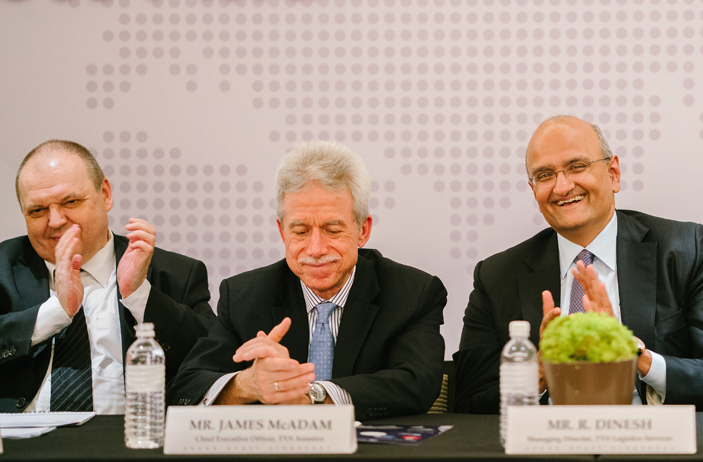WHEN a small company grows in scope and reach, but runs short on funds, it could accept that as a fact of doing business.
Or it could consider this the launch pad to the next phase of growth.
Being in the right place at the right time could see its future stretch out further, as it has for Pan Asia Logistics (PAL).
PAL was founded in Singapore in 2002 by Christian Bischoff and Susan Tan and took off in an unexpectedly successful fashion.
But when the funding ran out for further growth, expansion by acquisition was the next-best route. With annual revenues of S$160 million and a reputable presence in 12 countries in Asia and Germany, the 600-strong company was well positioned for acquisition.
“It was not easy to let go, but a wide network is key to success,” said Bischoff at the press conference to announce the next step.
Bischoff and Tan decided to relinquish hold for the greater good. They sold the business in its entirety to Singapore-based supply chain solutions company TVS Asianics (TVSA) for an undisclosed amount. Negotiations took more than a year, and the business is positioned to take advantage of TVSA’s network of influence and resources.
You Might Also Like To Read:
Carbon Tax — A New Source Of Income
A Different Sort Of Fishing Tale

Building Strong Links
Asia’s booming infrastructure projects, its expanding population and a rising middle class with an appetite for consumerism courtesy of technology are elements of a perfect storm of activity for big players keen on growth strategies.
James McAdam, CEO of TVSA, is looking to invest $100 million in the business to develop it in the region.
The Asia-centric logistics service provider operates in 13 Asian countries and employs over 1,000 people. It is part of the privately held global Indian conglomerate, TVS Group.
With 8,000 Indian companies registered in Singapore, and trade between Asean and India rising steadily from US$2.9 billion in 1993 to S$58.4 billion in 2016, the opportunities between these two blocs are abundant.
R. Dinesh, the Chairman of TVSA, is a fourth-generation family member of the US$7 billion TVS Group, which has around 45,000 employees.
“Logistics is a big field and we see many avenues of growth,” he says.
“Even before China’s Belt and Road initiative, we were looking to invest in Singapore. It has the right ecosystem and we foresee an average of 25-30% of growth per year for the next five years,” he explains.
Keeping Customers Close
McAdam, a 30-year veteran of the logistics industry, reckons that the closer TVSA is to its customers, its services will be in greater demand.
TVSA is investing heavily in technology to offer customers more insight into the customer chain, by allowing them to track packages end-to-end.
The supply chain focus shifted to Asia 10 years ago and TVSA wants to secure its position and current status by offering high-tech, end-to-end services under one roof owned.
David MacMillan, TVSA’s Chief Commercial Officer, chimes in for the need to “protect the supply chain” as the “cost of conversion” becomes too high the more entrenched customers and suppliers become.
He explains TVSA’s strategy to invest ahead of the demand. “We identified technology platforms to invest in, more than a year ago. We rolled them out, tested them and developed our own dashboards. We did this confident that the volumes would double or triple in a very short period of time, by virtue of acquisitions.
“Our teams are working to have a uniform back-end system in all our companies. In two years, we will be ready,” MacMillan adds.
Opportunities Within Asia
Beyond the global supply chain opportunities, TVSA is focusing its attention on regional growth within Asia.
“Intra-Asia business is quite significant. Some 60% of the world’s population is here, so if we position ourselves well, we can build on this base,” McAdam adds.
“We are looking specifically at growth in Vietnam, Indonesia, Thailand, China and India. Our view has always been to be very strong in those markets,” he stresses.
Looking to the future, McAdam paints a picture of potentially sizable growth for the industry.
“In 20 years, Indonesia will have five or six of the world’s largest cities, each with billion-dollar-plus GDP per annum. Just 10 years ago, none of those cities were anywhere on the map.”
And while Singapore may not have such huge volumes as their larger neighbours, its growth is still inexorably linked to and driven by the Southeast Asian market.
“Goods may not be destined for Singapore, but as a distribution point, they come through the Republic. That’s a large part of the business for PAL,” McAdam adds.
It also means that Singapore will continue to serve a key role in the flow of goods in a busy region, as TVSA builds stronger links in the supply chain.
Main image: Shutterstock



















